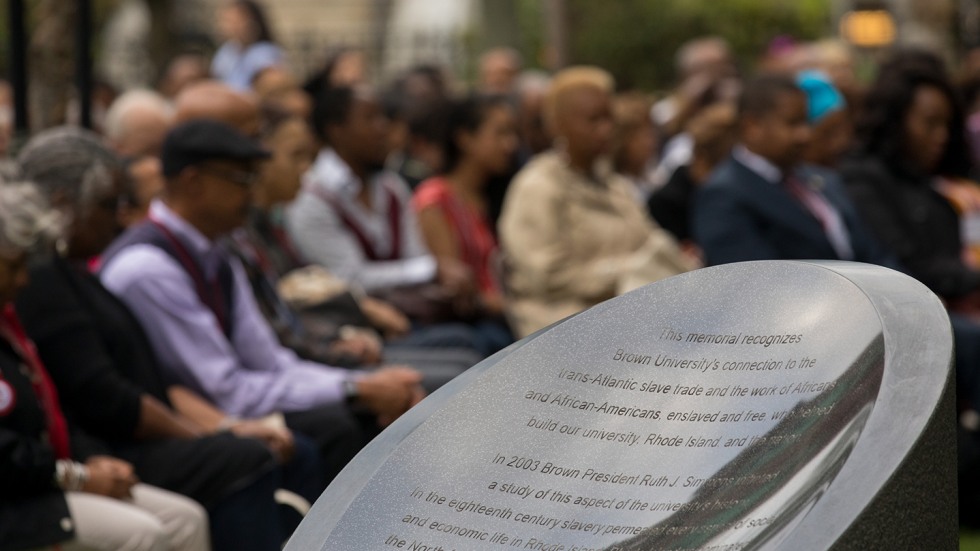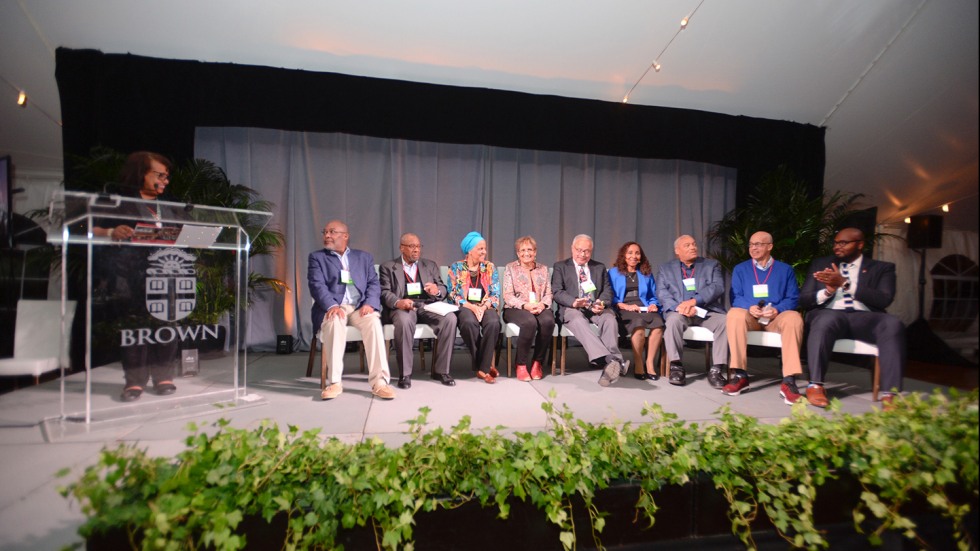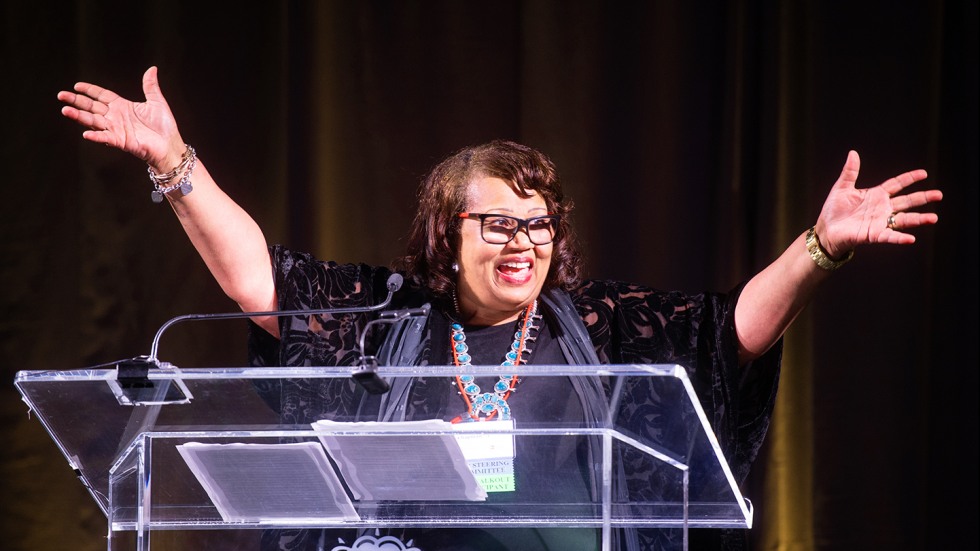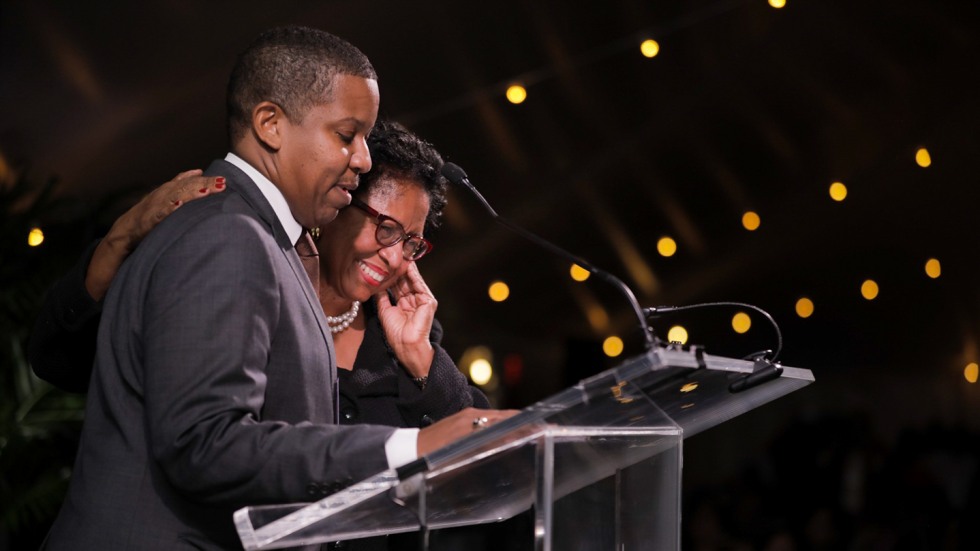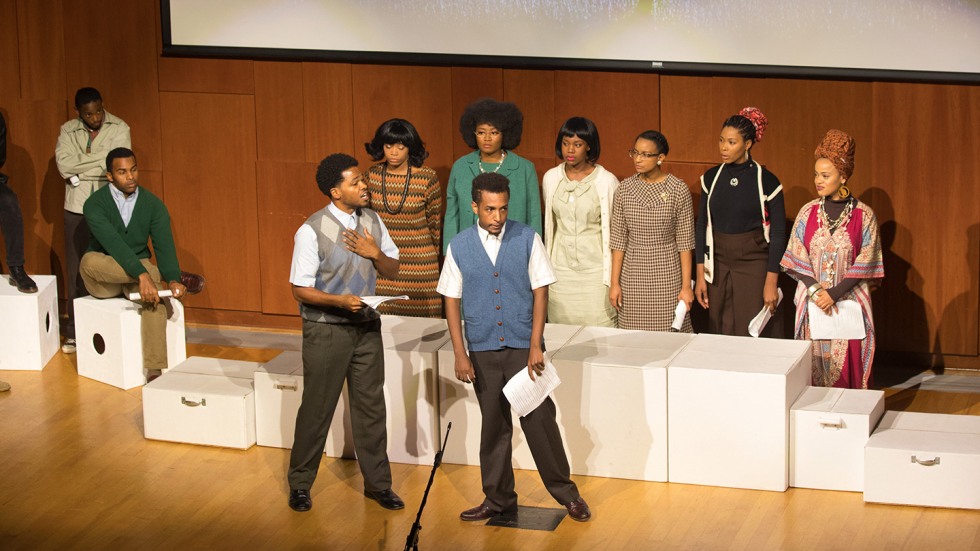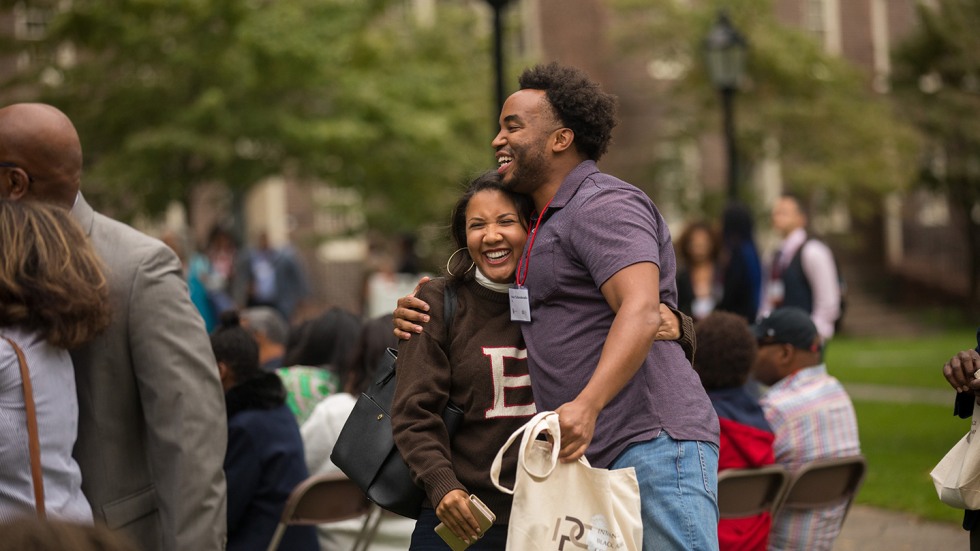PROVIDENCE, R.I. [Brown University] — The joy of rekindled friendships. The power of conversations on the black lived experience. The enduring legacy of a key moment in University history and generations of successive actions it inspired. Pride in each other’s journeys in life.
For more than 600 Brown University alumni of color and family members, the largest-ever Black Alumni Reunion at Brown offered the chance to celebrate this and so much more across a weekend of events from Sept. 21 to 23.
The reunion was convened by the Inman Page Black Alumni Council (IPC) at Brown with support from the Brown Alumni Association and academic and administrative departments at the University.
IPC President Russell Malbrough, a Class of 1998 graduate, said the weekend gave alumni from across the decades the opportunity to reflect on defining moments in Brown’s history and progress made to date — yet to examine also the unfinished business of advancing diversity and inclusion on campus.
“We recognize the courage, initiative and hard work behind making a black legacy at Brown and a pathway to social change and inclusivity within the boundaries of College Hill that’s taken many twists and turns,” Malbrough said. “This will continue to be a labor of love for all of us who value the University’s overarching mission and hope to see its doors open to more deserving students and faculty each passing year.”
Remembering the Walkout
On the opening evening of Black Alumni Reunion, nine participants from the seminal 1968 Black Student Walkout took to the stage under a tent on Ruth J. Simmons Quadrangle. Together, they reflected on the emphatic statement they made by leaving campus during that tumultuous year in the Civil Rights Movement.
The Walkout began on Dec. 5, 1968, when 65 of the 85 black students enrolled at Brown marched down College Hill to Congdon Street Baptist Church. There they found shelter as they negotiated with Brown leaders for increased social, academic and financial support for black students. On Dec. 9, the Walkout ended when they obtained the University’s agreement to launch an effort to significantly increase the number of black students in each new class.
The intensity of the moment was enormous, Class of 1970 graduate Daniel Thompson Jr. recalled.
“I had never experienced or imagined the intense feelings — the fear — that we experienced walking down that hill,” Thompson said.
Gail DeCosta, a Class of 1969 alumna, said that while the details have faded from memory over 50 years, the emotions she experienced during the Walkout are impossible to forget. “We had a real sense of camaraderie among us,” DeCosta said. “We were in this together and we were going to stick it out together.”
The participants’ reflections during the event made clear that the Walkout’s impact on their lives varied widely.
Class of 1970 graduate Glenn Dixon said the Walkout gave him a “personal, moral and ethical compass” that he has repeatedly called in the years since.
Class of 1972 alumna Zylpha Pryor-Bell said the prolonged, intense experience in Congdon Street Baptist Church awakened a desire to embrace her blackness.
Class of 1969 graduate Kenneth McDaniel said the value of the students’ preparations before the Walkout — gathering demographic data on students admitted to Brown, for example — demonstrated the benefit of taking a strategic, well-researched approach.
Class of 1971 alumna Sheryl Brissett-Chapman — a student leader during the Walkout and a co-chair of Black Alumni Reunion along with Rosetta Hillary, Class of 1973 — said that perspectives on the Walkout and its legacy are as diverse as the 65 individuals who participated.
“Everybody’s perspective is unique...” Brissett-Chapman said. “There is no generalization or stereotype of what the journey meant to them.” By considering the individual perspectives of those who participated in the Walkout, she added, “maybe then we can find some collective truth that can continue to fuel the progress” that Brown aspires to, 50 years after that momentous moment.
Many of the participants noted the immense effect the Walkout had on inspiring successive generations of student activists at Brown, who have built on the effort they initiated to create a more diverse and inclusive Brown community.
“What’s the ripple effect of getting to know people of other races as people?” Pryor-Bell asked. “The Brown graduate in the work world is a fairer and more open-minded person. In the neighborhood, the Brown graduate is more accepting and welcoming of racial diversity... To me, this is the most valuable impact of the Black Student Walkout. It brought and continues to bring people of different races in contact with one another where they already share a common goal of acquiring an exceptional education.”
A call to action and a legacy honored
On Saturday evening, the IPC presented Brown President Emerita Ruth J. Simmons — who as Brown president launched the University’s trailblazing exploration of its historic ties to the trans-Atlantic slave trade — with its inaugural Black Legacy Award.
Simmons delivered the weekend’s keynote address, noting how remarkable it is when “courageous and selfless actions” like the Walkout reach so far beyond their immediate intentions.
“The students planning the 1968 Walkout could not have envisioned where those proud steps would lead,” she said. “As it turns out, they led beyond Congdon Street Baptist Church and into the annals of the historic struggle for equal opportunity in America.”
Yet Simmons offered a forceful reminder that the struggle for equal rights remains an elusive goal. Bigotry has been reawakened, affirmative action is under threat, and many in America have been conditioned by centuries of injustice to endure unfair treatment, she said.
The social consciousness of students at Brown, at Prairie View A&M in Texas, where Simmons currently serves as president, and on campuses across the country is reason for optimism, she said.
“I wandered up the hill today and happened upon Brown’s first-year students...” she said during her address. “It is a marvelous thing to see them with their aspirations... But they are going to falter. They are going to become discouraged. They are going to have moments when they think it isn’t worth it. You must be in a position to pick them up.”
But support for younger generations is simply a start, she told the alumni who gathered for Black Alumni Weekend. It is never enough to merely cheer people on from the sidelines.
“Each of us should redouble our efforts tonight, thinking about those brave young people who walked out [in 1968]...” Simmons said. “In the tradition of the student protest that opened doors for so many at Brown, let us agree — we will persist in efforts to defeat bigotry until victory is won.”
In introducing Simmons on Saturday evening, Brown President Christina Paxson said that it has been an honor to build upon the foundation created by previous generations of students and leaders at Brown, and to continue to advance equity and inclusion on campus.
Paxson said that in addition to the tangible gains the University has made, symbolic actions matter, too. To that end, she announced to resounding applause that Brown will rename one of the most heavily-trafficked buildings in the heart of College Hill as Page-Robinson Hall in honor of two trailblazing black graduates.
The six-story academic and administrative facility is currently known as the J. Walter Wilson building, home to a variety of student-focused offices and services. It will be renamed for Inman Edward Page — who, with a classmate, became one of the first two black graduates of Brown in 1877 — and Ethel Tremaine Robinson, who earned her degree in 1905 as the first black woman to graduate from the University.
“Inman Page was born into slavery, sought liberty and opportunity and found them at Brown — and he saw the power of education to cultivate the innate ‘genius’ in everyone,” Paxson said. “Ethel Robinson broke a color barrier and a glass ceiling when she graduated from Brown in 1905. Together, these two pioneers embodied the faith in learning, knowledge and understanding that has animated Brown for generations.”
Diversity and inclusion in 2018
Early on Saturday in a session titled “Promoting Inclusivity on College Hill and Beyond,” Provost Richard M. Locke pointed to considerable increases in the number of students and faculty from historically underrepresented groups as early successes since the launch of the University’s ambitious diversity and inclusion action plan. Just as important, he said, has been the expansion of courses, research, speakers and programs centered on issues of diversity, inclusion and social justice.
“We want to play an intellectual leadership role in these areas,” Locke said. “We are really bringing to the forefront not just that this is the right thing to do, but it’s the smart thing to do. If we are going to be known as a university that attracts the best and brightest from all walks of life, then we have to walk the talk.”
The challenge moving forward, Locke and his fellow panelists agreed, will be institutionalizing Brown’s commitment to diversity and inclusion so that it remains permanently embedded in the University’s culture — not contingent on the presence of specific leaders or on episodes of student activism.
“We put our resources into every single aspect of the institution so that diversity is centered — it’s not just this additional thing that people are required to do,” Vice President for Institutional Equity and Diversity Shontay Delalue said during the session. “If you ask any faculty member or student, ‘Do you care about academic excellence and innovation?' they will say yes. You can’t have those things without diversity.”
Since the 2016 launch of the diversity and inclusion action plan, investments by the University and its alumni have been critical in enabling Brown to recruit students and faculty from historically underrepresented groups, speakers noted. Sergio Gonzalez, Brown’s senior vice president for advancement, shared news with reunion attendees of two new efforts that will support medical and undergraduate students, respectively.
In honor of longtime Brown educator, mentor and administrator Levi Adams, a new Levi C. Adams Medical Scholarship will support the next generation of African American physicians working to earn M.D.s at Brown’s Warren Alpert Medical School. Separately, the IPC launched an effort to raise $100,000 toward the establishment of a Brown Annual Fund scholarship to support exceptional African American students for four years of study beginning in 2019-20, Gonzalez noted.
Pride in each other’s journeys
For many of those who ventured to College Hill, Black Alumni Reunion marked a time to reconvene with fellow graduates and to build community, including for some who had not returned to campus in decades.
“This is the first time I’ve been back to a reunion at Brown, and it was really only because of the Walkout that I decided to come back...” Class of 1969 graduate Ido Jamar said during the Walkout reflection on Friday evening. “I’m glad to be back. I’m glad to see all of you.”
Workshops throughout the reunion featured a wide range of accomplished Brown alumni, who explored topics from health disparities, to race and sports, to the intersection of technology and society.
Shane Lloyd, who earned a master’s from Brown in 2011 and now works at Yale University’s Afro-American Cultural Center, led a discussion that convened alumni from a variety of identity groups to explore the evolution of intersectional social action at Brown.
“This panel elucidates this work of sharing and advancing movements that were birthed from the movement we are celebrating today — the 1968 Black Student Walkout,” Lloyd said.
Participants reflected on the successes and tensions that emerged in building coalitions to effect change at different points in Brown’s history — from organizing in the 1980s to protect lesbian, gay and bisexual students within the University’s nondiscrimination policy, to the push for need-blind admissions, to the much more recent effort to recognize Indigenous People’s Day on campus.
Separately, Class of 1974 graduate Alyce Johnson hosted a workshop on the experience of being black at Brown. Alumni from across the generations discussed their student years, unearthing many commonalities. Many praised the Open Curriculum for opening doors and helping them to think both critically and creatively. Across the classes, participants recalled deep connections with other black students during their time at Brown — with some saying they often felt, in contrast, separate from their white peers.
Several participants noted the importance of offering support to today’s students of color at Brown, including formal mentoring around career opportunities.
“One of the things we have an obligation to do is to keep the door open for the students who came after us,” one participant said. “If we don’t keep it open, it could close very quickly”
At the Slavery Memorial on the Quiet Green, which recognizes Brown’s connection to the trans-Atlantic slave trade, attendees convened on Friday for a ceremony to honor ancestors. On the same afternoon, a curator led alumni through “The Civil Rights Movement: Unfinished Business,” a Center for the Study of Slavery and Justice exhibition at Nightingale-Brown House on the legacy of the Southern Freedom Movement.
And alumni who packed Brown Stadium for the Brown vs. Harvard football game on Friday night — final score: Crimson 31, Bears 17 — saw a group of former Bears athletes recognized. Among them was pioneering blues music producer and professional football player J. Mayo “Ink” Williams, Class of 1921. Not only was Williams accomplished enough to earn election to the Blues Hall of Fame, he was one of the first three black players in the National Football League in 1920. Next month, Williams will be formally inducted into the Brown University Athletic Hall of Fame.
In addition to Simmons, other keynote speakers during the weekend included 1976 graduate Debra L. Lee, former CEO of BET Networks and one of the most influential voices in the entertainment industry; Class of 1986 graduate and Pulitzer Prize-winning playwright Lynn Nottage; and acclaimed spiritual teacher Iyanla Vanzant, who addressed alumni during a Sunday morning worship and celebration.
Paxson noted that for her, Black Alumni Reunion felt like the coming together of a community that has endured, blossomed and created legacy at Brown and beyond.
“This weekend, we celebrate a rich and profound history of black legacy, in all of its resilience in the world, and in all of the ways it is woven into the fabric of Brown University,” Paxson said.
